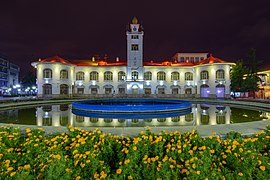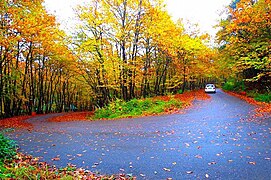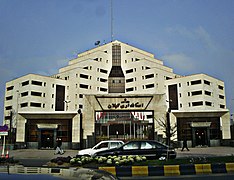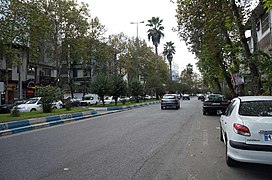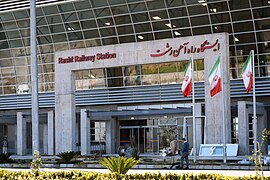Rasht
Rasht
| |
|---|---|
City | |
Municipal hall at night, Mirza Koch tomb, Saint Mesrop Church, Kolah Farangi mansion, Gilan Rural Heritage Museum, Gulzar bath, National library. | |
| Nicknames: Rain City, Rasht-Heaven | |
| Coordinates:37°16′28″N49°35′20″E/ 37.27444°N 49.58889°E[1] | |
| Country | Iran |
| Province | Gilan |
| County | Rasht |
| District | Central |
| Government | |
| • Mayor | Rahim Shoghi[2] |
| • City Council Chairman | Mohammad Hossein Vasegh Kargarnia |
| Area | |
| • Total | 95 km2(37 sq mi) |
| Population (2016)[3] | 679,995 |
| Time zone | UTC+3:30(IRST) |
| Area code | 013 |
| Website | rasht |
Rasht(Persian:رشت;[ɾæʃt])[a]is a city in theCentral DistrictofRasht County,Gilanprovince, inIran.Rasht serves as capital of the province, the county, and the district.[5]The city is also known as the "City of Rain"(شهر باران,Šahr-e Bārān) and, with a population of 679,995 in 2016,[3]is the most populous city ofnorthern Iran.
Rasht is the largest city on Iran'sCaspian Seacoast. Due to being between the coast and the mountains, the local environment is rainy with ahumid subtropicalclimate. It also hastemperate rainforestto its south, contrasting to the mostly arid Iran.
It is a major trade center betweenCaucasia,Russia,and Iran using the port ofBandar-e Anzali.Rasht is also a major tourist center with the resort ofMasoulehin the adjacent mountains and the beaches of Caspian as some of the major attractions.
Historically, Rasht was a major transport and business center which connected Iran to Russia and the rest of Europe, and because of this was known as the "Gate of Europe". The city has a history that goes back to the 13th century but its modern history dates back to theSafavidera during which Rasht was a major silk trade center with numerous textile workshops. In 2015, this city joined the network of creative cities of the world as a creativegastronomycity under the supervision ofUNESCO.
Etymology[edit]
There are multiple views about the city's name:[6][7]
- The root of the city's name is the wordresh(Persian:"رش") meaningvery light rain.The wordVaresh(fa:وارش) meaning "rain" ingilaki,indicates that this word is a combination ofVa+resh(fa:وا+رش)
- Another point of view is that the correct pronunciation of the city's name isResht(fa:رِشت) that is taken from the rootRisidan(fa:ریسیدن) orReshtan(fa:رشتن,both meaningspin)[8]and the reason for this name is the importance of the city in the production ofsilkthreads.
History[edit]

Timeline[edit]
- 682: Rasht was first mentioned inUmayyadhistorical documents.
- 1669:Stenka Razin,aCossackwarlord, plundered the city.
- 1714: Rasht destroyed by earthquake.
- 1722–1732:Occupationby theRussiansdue to theRusso-Persian War.
- 1901: A major epidemic plague devastates the city.
- 1917–1920: The Russian and British armed forces fight in the port city ofBandar-e Anzaliand Rasht. The British retreat and the Russians occupy the area.
- 1920–1921: The short-livedGilan Soviet Socialist Republicwas established with its capital in Rasht.
- 1937: A revolt, sparked by the desire to collect a "road tax" from the Russians, was suppressed.
- 1974: First university established in Rasht.
Rasht was first mentioned inUmayyadhistorical documents in 682 CE, but it is certainly older than this and appears on thePeutinger Mapoflate antiquity.It has seen theSassanidera, theRashidunconquest, the armies ofPeter the Greatand laterRussian rulers,andBritish colonialism.The people of Rasht also played a major role in theConstitutional Revolution of Iran.
Rasht has, along with regions around Tabriz and Tehran, one of the earliest industry plants during the last quarter of the 19th century, prominently in fields such as fishing, caviar production, the Caspian sea oil pipeline construction and textiles. During the 20th century, until the mid-70s, Gilan and the Rasht region was the third-ranking industrial city in Iran by number of workers and per capital productivity. It lost its cultural and industrial status to a large extent after the 1970s.
The people of Rasht played a prominent role in instigation and radicalization of thePersian Constitutional Revolution(1905–1907). Rasht is the birthplace ofMīrzā Kūchak Khān,one of the leading figures of the Constitutional Revolution. His own movement inGilan,which went by the name ofJangalis,represented a pro-modern and social democratic program for reformation of Muslim rituals and traditions. Mirza established the short-livedPersian Socialist Soviet Republicin 1920 after the defeat of the constitutional forces and in coalition with Iranian communists.
The republic had the support of the newly established Russian Red Army. The Soviet Government, after a turn of military and political strategy proposed by Trotsky, withdrew its support and the republic itself was tormented by the inner conflicts between the newly establishedIranian Communist Party(1919) and the Jangalis and other factions. The republic was finally defeated by the Iranian army under the command of Reza Shah.
The first national library of Iran was established in Rasht under theQajar dynasty.Nasim-e-Shomal,the first[citation needed]modern newspaper of Iran after the constitutional revolution, has been initially published in Rasht. First Public Library of Iran was built in Rasht City.[3]First Branch of the First Iranian Bank (Sepah Bank) was located in Rasht City.[9]First branch of 24/7 pharmacy (Karoon pharmacy) was built in Rasht City. First school for girls and first fire station in Iran were also built in Rasht City. The city of Rasht was the center of Gilan and the center of the first province of the country.
During theQajarperiod, along with economic development between Iran and Russia, Noghan trade and other products expanded. Thus, Rasht became the gateway toEuropein the 19th century.Grigoriy Melgunov,a Russian orientalist and writer who visited Rasht at the end of 1860, wrote in his published notes that the city at that time had 5463 houses, 1021 shops, 22 mosques, 34 schools and 17 bathhouses, and a population of 27,314.[10]At that time, Rasht's political credibility was such that theRussian,British,andOttomangovernments had consulates in Rasht.[11]
Modern day[edit]
Rasht is turning into an industrialized town like most of the Iranian large cities and province capitals. Enjoying the Kadus International Hotel and hundreds of tourist attractions, Rasht receives thousands of foreign tourists annually, mostly fromAustria,Germany,Netherlands,France,Australia,JapanandAfricancountries likeSenegalandCameroonas well as countries fromOceanialikeMicronesia.
Rasht is known for its famous municipal building, located in the Square of Municipality, which was constructed circa 1900, and has been renovated each year. Due to the high amount of humidity in Rasht which damages and destroys the aged buildings, the native, older architectural texture of Rasht is gradually being replaced with the modern skyscrapers and apartments.
The culture ofconsumerismis prevalent among the people of Rasht as a cultural and urban center which is historically engaged in close commercial and political ties with theUnited Kingdom,RussiaandFrance.Due to this background which makes the inhabitants much familiar with the industrial, cultural and political developments of the west, the finance and credit institutions are more willing to open representative offices and bureaus in Rasht and it has made the city a center of various banks and financial organizations.
There are many commercial centers, malls and financial institutions in Rasht including one branch of the Exports Development Bank of Iran which is an international bank dealing with the Iranian exports. The organizers and directors of national Iranian or non-Iranian banks afford to spend considerable amounts of budgets to construct attractive and modern buildings for their offices in Rasht.

Since theIslamic Revolutionof 1979 in Iran, there have always been requests on behalf of Russian,TurkishandAzeribanks to open branches in Rasht and that is why the city is endowed as the "gate of Europe" in Iran. The head consulate of theRussian Federationgovernment is located in Rasht and some of the otherCaspian regioncountries are also keen to establish representative headquarters in Rasht alongside their embassies inTehran.
Some evidences are theUniversity of Gilanwhich was constructed jointly by the governments ofIranandWest Germanyabout 40 years ago, the building ofIRIBrepresentatives in Rasht which was constructed jointly by the Iranian andBelgianengineers.
-
Bigler-Beigi Pavilion, fromQajar dynasty
-
Mohtasham Park in Rasht
-
Rasht Municipality
-
Rasht Saravan Park
-
Governor Building of Guilan in Rasht
First of Iran[edit]

- The first branch ofBank Sepahand first Bank of Iran was established in Rasht in 1925[12]
- The first girls' school in Iran was established in Rasht[13][14]
- The first day & night pharmacy in Iran was established in Rasht[15]
- The first sanatorium for the elderly and disabled in Iran was established in Rasht[16]
- The first National Library of Iran was established in Rasht in 1920[13]
- The first bus Iran arrived in Rasht[17]
- The first city in which the sewage system was established
- The first city in which theRussian,British,Frenchand Ottoman governments opened their consulates and had political representatives.[13]
- The first silk factory in Iran[18]
- The first national hospital in Iran named Poursina Hospital[19]
- The first classical theater in Iran[20]
Streets and boulevards[edit]
- Golsar Street
- Imam Ali Boulevard
- Shahid Chamran Boulevard
- Ayatollah Taleghani Boulevard
- Resalat Street
- Shohaday-e Gomnam Boulevard
- Ostadsara Street
- Esteghamat Street
- Deylaman Boulevard
- Moallem Boulevard
- Imam Khomeini Boulevard
- Valiasr Street
- Enghelab Street
- Azadi Street
- Azadegan Boulevard
- Shahid Ansari Street
- Farhang Street
- Parastar Boulevard
- Bastani Shoaar Street
- Afakhra Street
- Pasdaran Street
- 22 Bahman Boulevard
- Alamolhoda Street
- Saadi Street
- Tohid Street
- Navab Street
- Gilan Boulevard
- Gholipour Boulevard
- Habibzadeh Boulevard
- Ansari Boulevard
- Suleman Darab Boulevard
- Takhti Street
- Bisotun Street
-
Golsar Street
-
Golsar Street
-
Gilan Street
-
Ansari Street
Climate[edit]
Rasht has ahumid subtropical climate(Köppen:Cfa,Trewartha:Cf). The climate is one of the wettest in Iran, with warm summers and cool winters, sometimes with snow.[21]The average humidity is above 80%, contrasting heavily with cities in many other parts of Iran. Sunshine hours, averaging roughly 1,700 per year, is lower than in most places in Iran and also compared to most places at this latitude. Rasht is also known as "The City of Rain".
| Climate data for Rasht, (normals and extremes 1991-2020) | |||||||||||||
|---|---|---|---|---|---|---|---|---|---|---|---|---|---|
| Month | Jan | Feb | Mar | Apr | May | Jun | Jul | Aug | Sep | Oct | Nov | Dec | Year |
| Record high °C (°F) | 27.5 (81.5) |
29.8 (85.6) |
38.0 (100.4) |
37.4 (99.3) |
38.6 (101.5) |
35.2 (95.4) |
36.6 (97.9) |
38.4 (101.1) |
40.0 (104.0) |
37.4 (99.3) |
32.3 (90.1) |
29.2 (84.6) |
40.0 (104.0) |
| Mean daily maximum °C (°F) | 11.6 (52.9) |
11.5 (52.7) |
14.7 (58.5) |
19.1 (66.4) |
24.4 (75.9) |
28.5 (83.3) |
30.5 (86.9) |
30.9 (87.6) |
27.2 (81.0) |
22.8 (73.0) |
17.0 (62.6) |
13.3 (55.9) |
21.0 (69.7) |
| Daily mean °C (°F) | 7.1 (44.8) |
7.0 (44.6) |
9.7 (49.5) |
14.0 (57.2) |
19.6 (67.3) |
23.8 (74.8) |
25.7 (78.3) |
25.7 (78.3) |
22.3 (72.1) |
17.9 (64.2) |
12.5 (54.5) |
8.9 (48.0) |
16.2 (61.1) |
| Mean daily minimum °C (°F) | 3.8 (38.8) |
3.9 (39.0) |
6.6 (43.9) |
10.5 (50.9) |
15.9 (60.6) |
19.8 (67.6) |
21.8 (71.2) |
21.7 (71.1) |
19.0 (66.2) |
14.6 (58.3) |
9.3 (48.7) |
5.6 (42.1) |
12.7 (54.9) |
| Record low °C (°F) | −11.6 (11.1) |
−9.0 (15.8) |
−2.1 (28.2) |
−0.2 (31.6) |
3.8 (38.8) |
12.1 (53.8) |
14.8 (58.6) |
14.8 (58.6) |
11.5 (52.7) |
7.8 (46.0) |
−3.6 (25.5) |
−3.5 (25.7) |
−11.6 (11.1) |
| Averageprecipitationmm (inches) | 131.4 (5.17) |
131.6 (5.18) |
108.3 (4.26) |
73.1 (2.88) |
41.5 (1.63) |
41.7 (1.64) |
52.3 (2.06) |
71.8 (2.83) |
159.3 (6.27) |
200.4 (7.89) |
218.2 (8.59) |
153.2 (6.03) |
1,382.8 (54.43) |
| Average extreme snow depth cm (inches) | 6.09 (2.40) |
4.46 (1.76) |
0.62 (0.24) |
0.0 (0.0) |
0.0 (0.0) |
0.0 (0.0) |
0.0 (0.0) |
0.0 (0.0) |
0.0 (0.0) |
0.0 (0.0) |
0.53 (0.21) |
0.6 (0.2) |
6.09 (2.40) |
| Average precipitation days(≥ 1 mm) | 10 | 10.2 | 10.1 | 7.3 | 6.2 | 4.1 | 3.9 | 5.9 | 8.7 | 10.4 | 11.3 | 9.9 | 98 |
| Averagerelative humidity(%) | 85 | 85 | 84 | 82 | 80 | 77 | 77 | 79 | 84 | 87 | 88 | 86 | 83 |
| Averagedew point°C (°F) | 4.2 (39.6) |
4.1 (39.4) |
6.7 (44.1) |
10.5 (50.9) |
15.6 (60.1) |
19.2 (66.6) |
21.1 (70.0) |
21.4 (70.5) |
19.4 (66.9) |
15.5 (59.9) |
10.2 (50.4) |
6.2 (43.2) |
12.8 (55.1) |
| Mean monthlysunshine hours | 97 | 91 | 106 | 128 | 190 | 234 | 234 | 210 | 143 | 124 | 98 | 93 | 1,748 |
| Source: NOAA[22]IRIMO(snow depth 2004-2023)[23] | |||||||||||||
| Climate data for Rasht (1956-2010,[i]records 1956-2020) | |||||||||||||
|---|---|---|---|---|---|---|---|---|---|---|---|---|---|
| Month | Jan | Feb | Mar | Apr | May | Jun | Jul | Aug | Sep | Oct | Nov | Dec | Year |
| Record high °C (°F) | 30 (86) |
31 (88) |
38.0 (100.4) |
37.4 (99.3) |
38.6 (101.5) |
37 (99) |
37 (99) |
38.4 (101.1) |
40 (104) |
37.4 (99.3) |
36 (97) |
32 (90) |
40 (104) |
| Mean daily maximum °C (°F) | 11.0 (51.8) |
11.2 (52.2) |
13.5 (56.3) |
19.0 (66.2) |
24.0 (75.2) |
28.1 (82.6) |
30.3 (86.5) |
30.2 (86.4) |
26.7 (80.1) |
22.1 (71.8) |
17.5 (63.5) |
13.5 (56.3) |
20.6 (69.1) |
| Daily mean °C (°F) | 6.7 (44.1) |
7.0 (44.6) |
9.4 (48.9) |
14.3 (57.7) |
19.2 (66.6) |
23.2 (73.8) |
25.3 (77.5) |
25.3 (77.5) |
22.2 (72.0) |
17.7 (63.9) |
12.9 (55.2) |
8.9 (48.0) |
16.0 (60.8) |
| Mean daily minimum °C (°F) | 2.4 (36.3) |
2.7 (36.9) |
5.3 (41.5) |
9.6 (49.3) |
14.4 (57.9) |
18.2 (64.8) |
20.4 (68.7) |
20.3 (68.5) |
17.6 (63.7) |
13.3 (55.9) |
8.3 (46.9) |
4.4 (39.9) |
11.4 (52.5) |
| Record low °C (°F) | −19 (−2) |
−18 (0) |
−6.4 (20.5) |
−2 (28) |
3.6 (38.5) |
5 (41) |
11 (52) |
9 (48) |
7 (45) |
1 (34) |
−4 (25) |
−10 (14) |
−19 (−2) |
| Averageprecipitationmm (inches) | 132.4 (5.21) |
116.0 (4.57) |
112.5 (4.43) |
64.8 (2.55) |
51.5 (2.03) |
43.0 (1.69) |
42.3 (1.67) |
68.4 (2.69) |
152.5 (6.00) |
211.5 (8.33) |
186.8 (7.35) |
155.8 (6.13) |
1,337.5 (52.65) |
| Average precipitation days | 13.4 | 12.9 | 15.4 | 12.3 | 10.9 | 7.3 | 6.3 | 8.6 | 12.0 | 13.8 | 12.8 | 13.0 | 138.7 |
| Average snowy days | 2.5 | 2.8 | 1.3 | 0.1 | 0.0 | 0.0 | 0.0 | 0.0 | 0.0 | 0.0 | 0.1 | 0.9 | 7.7 |
| Averagerelative humidity(%) | 84 | 85 | 84 | 80 | 78 | 74 | 74 | 77 | 82 | 86 | 85 | 85 | 81 |
| Average afternoonrelative humidity(%) | 77 | 77 | 75 | 69 | 66 | 63 | 63 | 65 | 71 | 75 | 76 | 77 | 71 |
| Averagedew point°C (°F) | 3.8 (38.8) |
4.0 (39.2) |
6.3 (43.3) |
10.5 (50.9) |
15.3 (59.5) |
18.8 (65.8) |
20.7 (69.3) |
21.0 (69.8) |
19.0 (66.2) |
15.2 (59.4) |
10.4 (50.7) |
6.2 (43.2) |
12.6 (54.7) |
| Mean monthlysunshine hours | 91.7 | 86.7 | 91.2 | 122.0 | 174.0 | 213.2 | 222.1 | 187.7 | 140.2 | 118.3 | 100.2 | 89.6 | 1,636.9 |
| Source: Shahrekord Meteorology Database[24] | |||||||||||||
- ^Afternoon humidity measured at 09:00UTC.(12:30 IRST)
Demographics[edit]
Population[edit]
| Year | Pop. | ±% p.a. |
|---|---|---|
| 1986 | 290,897 | — |
| 1996 | 417,748 | +3.69% |
| 2006 | 551,161 | +2.81% |
| 2011 | 639,951 | +3.03% |
| 2016 | 679,995 | +1.22% |
| source:[25] | ||
The city of Rasht is the most populated city in the north of the country and one of the metropolises of Iran. At the 2006 National Census, its population was 551,161 in 159,983 households.[26]The following census in 2011 counted 639,951 people in 204,054 households.[27]The latest census in 2016 showed a population of 679,995 people in 228,142 households.[3]
Language[edit]
People of Rasht are mostlyGilaks(98/2%) and they speak Rashti variety ofWesternGilakilanguage.[28][29][30][31] [32] [33]
Culture[edit]
People of Rasht spend much on arts, food, and clothes. They spend the leisure times going to cinemas, art exhibitions, music concerts and international book fairs that are being held in the city most of times in a year. Also the municipality kicks off sports, cultural or IT-related competitions to involve the youth in healthy and constructive activities. The most beloved competition is the annualbloggingcompetition which awards the top young bloggers each year.
Rasht has played a major role in Iranian history. It was Iran's gateway to Russia and Europe; therefore it was influenced by western architecture. Iran's first public library was built here and it was the first city in Iran where girls were allowed to go to school.
Iranian cities of Isfahan and Rasht were accepted to theUNESCOCreative Cities Networkon December 11, 2015.Isfahanis registered because of its creative crafts and folk art; and Rasht because of its unique gastronomy.[34]Rasht embroideryis a handicraft and art specific to the city and Gilan province.[35][36]
On 4 January 2015, Rasht was selected as the political center of Gilan more than 4,500 years ago. The date 4 January was then included in the official calendar of the country as Rasht Day.
Cuisine[edit]
The dominant foods of Rasht people are various types of fish.Mirza Ghassemi,vavishka (a type ofhaggis),nargesi,baghala ghatogh,andashpal (roe)are some other popular local dishes.Reshteh khoshkaris a well-known sweet.Zeitoun Parvardehis a kind of delicacy prepared from olives and pomegranates; it is a popular seasoning in the city.[37]
Rose de Rescht[edit]
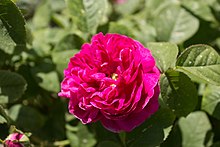
Rosa'de Rescht',like many old garden roses, presents an interesting historical background story. This cultivar, originating in Iran, was reported at the end of 19th century in England, but it was then forgotten. It was rediscovered near the Iranian provincial capital of Rascht by MissNancy Lindsayin 1945, and was brought back to the United Kingdom, where it was re-introduced around 1950. Today it is shown in the Victorian Class, winning many trophies.[38]
Sports[edit]
The people of Rasht have always been regular fans of football which is the beloved sport in the city. Most are fans ofDamash Gilanwho play in theAzadegan LeagueorSepidrood Rashtwho play in thePersian Gulf Pro League.Damash Gilanis the newer version of formerPegahfootball club that belonged to the municipality of Rasht, but was purchased later by the mineral water factory of Damash and changed its name and properties to Damash Gilan.
The home stadium of Damash Gilan isDr. Azodi Stadiumwhich is an old stadium dating back to almost 40 years ago and its capacity is 11,000 people. Sardar Jangal Stadium is the city's second stadium.
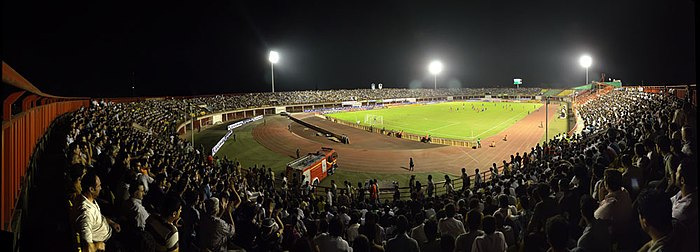
Following football,wrestling,judoandweightliftingare the most popular sports of youth in Rasht and that is due to the enchanting appearance of Iranian wrestlers and weightlifters in the international competitions likeOlympics.The outstanding figure of world weightlifting and the two-time olympics Gold medal winnerHossein Rezazadehis a main inspirer of Rasht youth to tryWeightliftingas their professional job.Asghar Ebrahimiwho was the squad captain of Iranian weightlifting team at the2008 Olympicsis from Rasht and a successful example of those youth from Rasht who tried this national field of sport afterHossein Rezazadeh.
Colleges and universities[edit]

- University of Gilan
- Gilan university of medical sciences
- Islamic Azad University of Rasht
- Jaber ebn Hayyan Institute of Higher Education
- Payame Noor University
- Institute of Higher Education for Academic Jihad of Rasht
- Guilan Technical & Vocational Training Organization[39]
- Gilan Advanced Skills Training Center[40]
- Rasht Technical and Vocational Institute[41]
- Guilan University of Applied and Scientific Technology[42]
Economy[edit]
This sectionneeds additional citations forverification.(October 2023) |
This city is greatly important based on its geographical situation (locating on the central plain and its large width, fertile lands and soil, being the most important region of the province and Iran in terms of rice cultivation), communicative situation (locating among Tehran–Qazvin-Anzali-Astara roads, in one hand, and the main road from Gilan to Mazandaran and the east of Gilan, on the other hand), political–administrative situation (situating as the capital city of Gilan province) and economic development, towns expansion and industrial factories and the following increase in the agricultural-commercial activities and in the number of science and technology centers.
The most residents of this city are active in service, trading and industrial jobs and paddy is the main activities of the villagers in this region.[43][44][45] Rasht has long been one of the most prominent customs cities in Iran. This city used to be the only communication and trade route of Iran to Europe through the Anzali port. From the time of Shah Abbas II until the end of the Qajar rule, the city of Rasht was a large commercial center, and caravans stopped in this city to buy silk and sell their goods from In this way, they were sent to the ports of the Mediterranean Sea.
The presence of the Russian Consulate and then the British Consulate in Rasht caused the economic and social prosperity of this city, and there was a representative of the Ministry of Foreign Affairs or a broker, a Russian consul, a French deputy consul, and a British deputy consul in this city, and apart from The ruler of Rasht, the agent of foreign affairs was also stationed in Rasht on behalf of the central government. During this period, Tomanians Russian Borrowing Bank and Trading House were active in Rasht consecutively.
At the same time, Rasht's foreign trade developed and most Rashtites became millionaires, and Rasht became an aristocratic city during the Qajar period. The city is served byRefah Chain Stores Co.,Iran Hyper Star,Isfahan City Center,Shahrvand Chain Stores Inc.,Ofoq Kourosh chain store.
Pharmaceutical industry[edit]
At present[when?],Rasht has a Faculty of Pharmacy under the auspices ofGilan University of Medical Sciencesand several drug production centers, one of which is a center for the production of anti-cancer nano-drugs with 24 pens. Sobhan Daroo Co. is one of the most successful pharmaceutical companies in Iran. And with more than 100 production licenses, it is currently the second largest producer in the country in terms of production volume. Sobhan Oncology Pharmaceutical Company is one of the most modern and advanced production units of anti-cancer and chemotherapy products in the world.[46]
Health centers and hotels[edit]
Hotel
- Kadus Grand Hotel
- Shabestan Hotel
- Ordibehesht Hotel
- Pardis Hotel
- Ghadir Hotel
- Pamchal Hotel
- Pourya Hotel
Hospital
- Poursina Hospital
- Golsar Hospital
- Arya Hospital
- Pars Rasht Hospital
- Rasoul Akram Hospital
- Velayat Hospital
- Omid Hospital
- 17 Shahrivar Hospital
- Dr. Heshmat Educational & Remedial Center
- Razi University Hospital
- Qaem Hospital
- Rasht Family Hospital
- Al Zahra Hospital
- Toton Karan Hospital
- Shafa Educational & Remedial Center
- Amir Al Mo'menin Educational Remedial & Research Center
Transportation[edit]
This sectionneeds additional citations forverification.(May 2024) |
Taxi[edit]
In 1947, 50 taxis were purchased from England by the order ofFakhr-ol-dowleh(daughter of Muzaffar al-Din Shah) and imported to Iran. In 1948, the first taxi entered Rasht by crossing the main street of the city due to his interest in Gilan. Rasht Metropolitan Taxi Organization has so far organized more than 9,500 taxis and private cars.
Railway[edit]
Rasht is served by Rasht railway station, which is located south of the city near the road toJirdeh, Shaft.[47] The railway passes through Alborz mountains and then Sefidrood river valley and is connected toKarajandQazvinon its way to Tehran. To the north the railway leads to Anzali free trade zone.[47]
International airport[edit]
TheRasht International airportis the only airport in the province of Gilan and was established in 1969 with an approximate area of 220 hectares. At first, the airport just handled domestic flights toTehranandMashhad,but after it was renamed to Sardar Jangal International airport in 2007, additional routes were established.
The airport is in close affiliation with hundreds of flights by national and international airlines, includingMahan Air,Iran Air,Iran Aseman Airlines,Kish Airand receives more than 2000 flights annually.
-
Rasht Airport
-
Rasht Railway Station
-
Terminal Rasht
Historical and natural attractions[edit]
- Municipal Complex
- Iran Hotel
- Post Building
- National Library
- Tomb of Mirza Kuchak Khan
- Mirza Kuchak Khaan House
- Safi Mosque
- Kolah Farangi Mansion
- Sabzeh Meydan Park
- Gilan Rural Heritage Museum
- Saravan Forest Park
- Gilan Rural Heritage Museum
- Rasht Museum of Anthropology
- Avanesian House
- Rasht Grand Market
- Hajj Samad Khan Mosque
- Haj Samiee Mosque
- Badyollah Mosque
- Qadiri House of Rasht
- Mirza Khalil House
- Governor's Building
- Mohtasham Garden
- Mafakher Park
- Emamzadeh Hashem
- Imamzadeh Ismail and Abbas
- Mellat Park
- Eynak Lagoon
- Keshavarz Park
- Meshkat Park
- Towhid Park
- Golshan Mosque
- Kase Forushan Mosque
- Zargaran Mosque
- Abrishamchi House
- Ashkouri House
- Seyyed Ali Moghimi House
- Mohtasham Caravanserai
- Haji Bath
- Ebrahim Pourdavoud Tomb
- Chomarsara Clay Bridge
- Gishe Damerdeh Bridge
- Gurab-e Lishavandan
- Tomb of Imam's sister
- Imamzadeh Bibi Zeynab
- Tomb Tower Danaye Ali
- Siah Estalakh Village
- Lat Carvansary
- Shahid Beheshti High School
-
The Historical Building of Post office
-
Mirza Kuchik Khan House
-
Hajj Samad Khan Mosque
-
Avanesian House
-
Mellat Park at Night
Notable people[edit]
- Hushang Ebtehaj(1928–2022) poet
- Hossein Sami'i(1876–1953) writer, poet, diplomat, and politician
- Mirza Kuchik Khan(1880–1921) revolutionary leader
- Aydin Aghdashloo(1940) painter, graphic artist, and art curator
- Reza Baluchi(born 1972) cyclist, athlete
- Mahmoud Behzad(1913–2007) biologist
- Mir Abdolrez Daryabeigi(1930–2012) painter
- Mohammad Bagher Nobakht(born 1950) politician and economist
- Fathollah Khan Akbar(1855–1937) Qajar dynasty prime minister
- Amir Eftekhari(born 1964) footballer
- Shaya Goldoust(born 1986), Iranian-born Canadian journalist, activist
- Khosrow Golsorkhi(1944–1974) journalist, poet, and communist
- Hadi Jelveh(1919–2011) associate justice of the Iran Supreme Court
- Alexander Kasimovich Kazembek(1802–1870) Azerbaijani-Russian Orientalist, historian, philologist
- Mohammad KhatamIranian air force commander and advisor to the Shah
- Hamideh Kheirabadi(1924–2010) actress
- Arsen MinasianThe Armenian founder of the first modern sanatorium in Iran
- Mohammad MoeinLinguistics and literature researcher
- Ardeshir Mohasses(1938–2008), illustrator, cartoonist
- Bahman Mohasses(1931–2010) painter, sculptor
- Youcef NadarkhaniChristian pastor sentenced to death for apostasy from Islam
- Mahmoud Namjoo(1918–1989) weightlifter
- Ardeshir Ovanessian,Communist leader
- Mohammad Nouri,singer
- Kazim Rashti,Shaykhi scholar
- Ebrahim PoordavoodAcademic
- Dariush RamezaniCartoonist
- Fazlollah RezaFormer Iran's ambassador toUNICEFand former manager ofSharif University
- Anoushiravan RohaniMusician
- Massoumeh Seyhoun(1934–2010) painter
- Sadeq SabaHead ofBBCPersian Service
- Majid SamieiNeurosurgeon and the Manager of Hanover Brain and Nerves Treatment institute
- Marjane Satrapi(born 1969) graphic novelist, cartoonist, film director
- Susan Taslimi(born 1950) actress
- Yahya Rahmat-Samii(born 1948),electrical engineer,professor at UCLA
- Farideh Lashai(1944–2013), painter
- Homayoon Toufighichess grandmaster
- Houchang NahavandiIranian professor and politician
- Habib Nafisi(1908–1984) engineer, educator
- Houman Seyyedi(born 1980) actor and director
- Shohreh Bayat(born 1987) chess arbiter
- Asghar EbrahimiIranian weightlifter
- Mahmoud EtemadzadehWriter
- Enayatollah RezaIranian historian
- Reza Ramezani GilaniMuslim cleric
- Esmaeil ElmkhahIranian weightlifter
- Nasrollah Moghtader MojdehiIranian professor
- Mohammad ToloueiWriter
- Asghar KardoustBasketball player
- Mohammad Rahbari(born 1991) fencer
- Babak ZarrinComposer
- Mohsen ForouzanFootballer
- Hadi TabatabaeiFootballer
- Saeid HassanipourKarateka
-
Kadus Grand Hotel
-
Velayat Hospital
Distance to major cities[edit]
| City | Km distance |
|---|---|
| Isfahan | 640 |
| Tehran | 326 |
| Kerman | 1250 |
| Mashhad | 1063 |
| Tonekabon | 137 |
| Amol | 295 |
| Shahrekord | 739 |
| Ahvaz | 956 |
Twin towns – sister cities[edit]
Notes[edit]
References[edit]
- ^OpenStreetMap contributors (6 October 2023)."Rasht, Rasht County"(Map).OpenStreetMap.Retrieved6 October2023.
- ^"خبرگزاری فارس - رحیم شوقی رسماً شهردار رشت شد".خبرگزاری فارس.4 May 2023.
- ^abc"Census of the Islamic Republic of Iran, 1395 (2016)".AMAR(in Persian). The Statistical Center of Iran. p. 01. Archived fromthe original(Excel)on 4 December 2020.Retrieved19 December2022.
- ^Rasht can be found atGEOnet Names Server,atthis link,by opening the Advanced Search box, entering "-3080876" in the "Unique Feature Id" form, and clicking on "Search Database".
- ^Habibi, Hassan (12 September 1990)."Approval of the organization and chain of citizenship of the elements and units of the national divisions of Gilan province centered on the city of Rasht".Islamic Parliament Research Center(in Persian). Ministry of Interior, Defense Political Commission of the Government Board. Archived fromthe originalon 12 October 2016.Retrieved12 December2023.
- ^""Rasht", a name with 900 years of root in Abgd words ".8deynews(in Persian). 8daynews. 1 November 2015.Retrieved3 April2024.
- ^"Where has the name" Rasht "come from?"(in Persian). Iranian students news agency. ISNA. 27 February 2019.Retrieved3 April2024.
news code:97120703825
- ^"Risidan - definition and meaning in Abadis dictionery".abadis.ir.Abadis.Retrieved3 April2024.
- ^[1]Archived2021-01-11 at theWayback Machine
- ^Melgunov, Grigoriy (1863).О южном береге Каспийского моря[On the south coast of the Caspian Sea] (in Russian). Saint Petersburg: Printing Office of the Imperial Academy of Sciences. pp. 220–221.
- ^The Adventures of a Frenchman in Rasht / Jean-Baptiste Nicola
- ^"History of the first Iranian bank".Archived fromthe originalon 27 February 2020.Retrieved8 June2020.
- ^abcRASHT i. The City / Encyclopædia Iranica
- ^"Rasht city of silver rain".Mehr News Agency.30 June 2019.
- ^"تاریخچه اولین داروخانه شبانه روزی ایران".afragostarco.
- ^Janet D. Lazarian (2003). Encyclopedia of Iranian Armenians. Tehran: Hirmand Publisher. pp. 301–302.ISBN964-6974-50-3.
- ^"اولین اتوبوس وارد شده به ایران".جهان نيوز.24 April 2013.
- ^History of the Russian presence in Iran / Page 395
- ^A Survey of Patients' Satisfaction in Emergency Department of Rasht Poursina Hospital
- ^"گیلان، مهد تئاتر ایران / درباره هنرهای نمایشی سرزمین هنر خیز".خبرگزاری هنر ایران.3 January 2024.
- ^"Rasht, Iran Climate Summary".Weatherbase.Retrieved1 April2015.
- ^"1991-2020 climate normals: Rasht, Iran".NOAA.Retrieved24 December2023.
- ^"Average Extreme Snow Height for Rasht (40719)".data.irimo.ir.Iran Meteorological Organization.Retrieved10 May2024.
- ^Climatological Norms of Iran synoptic stations.Retrieved on: September 12, 2011.
- ^"Iran: Provinces, Major Cities & Towns - Population Statistics, Maps, Charts, Weather and Web Information".citypopulation.de.
- ^"Census of the Islamic Republic of Iran, 1385 (2006)".AMAR(in Persian). The Statistical Center of Iran. p. 01. Archived fromthe original(Excel)on 20 September 2011.Retrieved25 September2022.
- ^"Census of the Islamic Republic of Iran, 1390 (2011)".Syracuse University(in Persian). The Statistical Center of Iran. p. 01. Archived fromthe original(Excel)on 8 October 2023.Retrieved19 December2022.
- ^Jahangiri, Dr. Nader.گویش گیلکی لاهیجان[Lahijani Dialect of Gilaki] (in Persian). Iran: Tokyo University of Foreign Studies.
- ^Resaei, Ayoub (2006),گویش گیلکی فومنات[Foumani Dialect of Gilaki] (in Persian), Iran:Allameh Tabataba'i University,p. 65
- ^Sotoudeh, Manouchehr (1953).فرهنگ گیلکی[Gilaki Culture] (in Persian and Gilaki). Iran: فرهنگ ایلیا. pp. 17, 18.
- ^Shokri, Giti (2006).گویش رامسری[Ramsari Dialect] (in Persian). Iran: پژوهشگاه علوم انسانی و مطالعات فرهنگی. p. 14.
- ^"Glottolog 4.6 - Western Gilaki".
- ^"Gilaki".
- ^"Iran attends UNESCO annual assembly on creative cities".Tehran Times.4 July 2017.
- ^"رشتیدوزی از لوازم خانه تا لباس"[Embroidery from home appliances to clothes].Modefasl.ir.21 November 2015. Archived fromthe originalon 22 November 2015.
- ^"رشتی دوزی و چموش دوزی هنرهای بومی" استان گیلان ""[Rashti Embroidery and Chamush Embroidery of local arts "Gilan province" ].Young Journalist Club (YJC)(in Persian). 2014.Retrieved15 March2022.
- ^"Gilan food tourism hub".iran-daily.31 August 2014.Retrieved16 June2017.
- ^"History of Rose de Rescht Rose".scvrs.homestead.
- ^"اداره کل آموزش فنی و حرفه ای استان گیلان".guilantvto.ir.
- ^"مرکز آموزش مهارتهای پیشرفته گیلان".gilastc.ir.Archived fromthe originalon 27 June 2010.Retrieved13 May2010.
- ^"دانشکده فنی و حرفه ای پسران رشت - شهید چمران".22 December 2014. Archived fromthe originalon 22 December 2014.
- ^[2][permanent dead link]
- ^"Rasht".Creative Cities Network - Unesco.
- ^Economy Flights to Rasht - TripAdvisor
- ^Rasht Today
- ^History of Pharmacy in Iran
- ^abOpenStreetMap Contributions"Rasht railway station"(in Persian). OpenStreetMap.Retrieved16 May2024.
- ^"About city".gums.ac.ir.Guilan University of Medical Sciences.Retrieved25 May2021.











